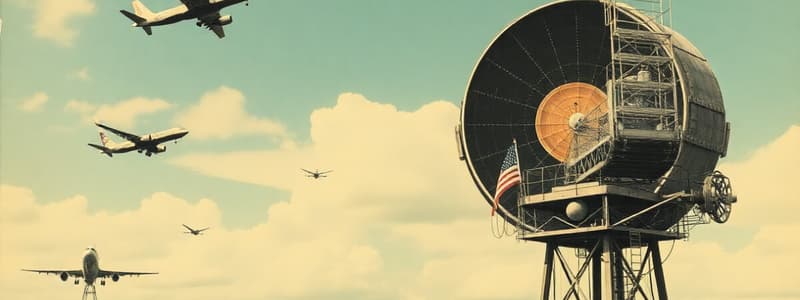Podcast
Questions and Answers
What is the recommended default mode for weather detection using the weather radar?
What is the recommended default mode for weather detection using the weather radar?
- Automatic Gain Mode (correct)
- Enhanced Gain Mode
- Calibrated Gain Mode (correct)
- Manual Gain Mode
Why is the accuracy of weather displayed at long distance ahead of the aircraft considered low?
Why is the accuracy of weather displayed at long distance ahead of the aircraft considered low?
- Increased beam width (correct)
- Narrow beam width
- Low signal reception
- Signal interference
During which flight phase should the flight crew set the tilt to a maximum of 15° up?
During which flight phase should the flight crew set the tilt to a maximum of 15° up?
- Takeoff (correct)
- Levels Off
- Descent
- Cruise
What is the main purpose of monitoring both long-distance and short-distance weather?
What is the main purpose of monitoring both long-distance and short-distance weather?
How should the flight crew adjust the tilt angle during the climb phase?
How should the flight crew adjust the tilt angle during the climb phase?
What is a common effect when not monitoring short-distance weather effectively?
What is a common effect when not monitoring short-distance weather effectively?
What adjustment should be made to ND range during the takeoff phase if necessary?
What adjustment should be made to ND range during the takeoff phase if necessary?
What should the flight crew do regularly during the level flight phase?
What should the flight crew do regularly during the level flight phase?
What is the purpose of the tilt control in the weather radar operation?
What is the purpose of the tilt control in the weather radar operation?
How often should the flight crew scan the area ahead of the aircraft?
How often should the flight crew scan the area ahead of the aircraft?
What should the flight crew do to obtain a correct display of a storm cell?
What should the flight crew do to obtain a correct display of a storm cell?
What may occur if the tilt setting is incorrect at high altitudes?
What may occur if the tilt setting is incorrect at high altitudes?
What is considered common practice when using the weather radar?
What is considered common practice when using the weather radar?
What does the IRS provide data for in the weather radar system?
What does the IRS provide data for in the weather radar system?
Why is it important to prevent overscanning of a storm cell?
Why is it important to prevent overscanning of a storm cell?
What characterizes cumulus clouds in terms of radar detection?
What characterizes cumulus clouds in terms of radar detection?
What tilt setting is recommended during descent to maintain ground returns at the top of the ND?
What tilt setting is recommended during descent to maintain ground returns at the top of the ND?
Which parameter is crucial for distinguishing weather returns from ground returns?
Which parameter is crucial for distinguishing weather returns from ground returns?
For an ND range of 80 NM, what is the recommended initial tilt setting at cruise altitude?
For an ND range of 80 NM, what is the recommended initial tilt setting at cruise altitude?
During approach, why is a 4° up tilt setting recommended?
During approach, why is a 4° up tilt setting recommended?
When flying above water, which tilt settings can be used at cruise altitude?
When flying above water, which tilt settings can be used at cruise altitude?
What is the tilt setting approximation for an ND range of 320 NM?
What is the tilt setting approximation for an ND range of 320 NM?
What happens to ground returns when the tilt setting is adjusted?
What happens to ground returns when the tilt setting is adjusted?
What is the appropriate tilt setting for tracking weather at 40 NM?
What is the appropriate tilt setting for tracking weather at 40 NM?
What does the weather radar primarily detect?
What does the weather radar primarily detect?
What may frequent lightning indicate during a flight?
What may frequent lightning indicate during a flight?
What should be established to identify the area of greatest threat from weather conditions?
What should be established to identify the area of greatest threat from weather conditions?
When should avoidance maneuvers be initiated in relation to convective weather?
When should avoidance maneuvers be initiated in relation to convective weather?
What should the tilt setting be during taxi and takeoff?
What should the tilt setting be during taxi and takeoff?
Which avoidance technique is preferred when navigating near dangerous weather?
Which avoidance technique is preferred when navigating near dangerous weather?
What ND ranges are recommended during cruise for good weather awareness?
What ND ranges are recommended during cruise for good weather awareness?
What is the priority in avoiding detected weather versus weather hazards?
What is the priority in avoiding detected weather versus weather hazards?
When is it advised to use manual tilt for storm cell analysis?
When is it advised to use manual tilt for storm cell analysis?
Why is vertical avoidance generally not recommended at high altitude?
Why is vertical avoidance generally not recommended at high altitude?
What action should be taken if possible during lateral avoidance?
What action should be taken if possible during lateral avoidance?
What action enhances the visibility of storm cell tops?
What action enhances the visibility of storm cell tops?
Why is assessing the vertical expansion of a storm cell important?
Why is assessing the vertical expansion of a storm cell important?
What should be done after performing manual scans in flight?
What should be done after performing manual scans in flight?
Which range is NOT recommended for tracking short-distance weather?
Which range is NOT recommended for tracking short-distance weather?
What is the primary purpose of setting tilt to AUTO during flight?
What is the primary purpose of setting tilt to AUTO during flight?
What should a pilot do to avoid turbulence and hail when flying near convective clouds?
What should a pilot do to avoid turbulence and hail when flying near convective clouds?
Which altitude separation should be applied when flying above a convective cloud?
Which altitude separation should be applied when flying above a convective cloud?
What is a significant risk of flying below a convective cloud?
What is a significant risk of flying below a convective cloud?
How may ice crystals negatively affect an aircraft?
How may ice crystals negatively affect an aircraft?
Where are areas of ice crystals typically found in relation to convective clouds?
Where are areas of ice crystals typically found in relation to convective clouds?
What happens when ice crystals contact a hot surface on an aircraft?
What happens when ice crystals contact a hot surface on an aircraft?
Why should visual judgment not be the only factor considered when flying below a convective cloud?
Why should visual judgment not be the only factor considered when flying below a convective cloud?
What could potentially happen if an aircraft flies in an area with a high concentration of ice crystals?
What could potentially happen if an aircraft flies in an area with a high concentration of ice crystals?
Flashcards
Weather Radar Tilt
Weather Radar Tilt
The angle between the radar antenna beam and the horizon. Independent of aircraft pitch and bank.
Radar Tilt for Strong Returns
Radar Tilt for Strong Returns
Tilt the radar antenna up and down to find strongest reflections from weather (storms).
Correct Tilt Setting
Correct Tilt Setting
Aims radar beam at the most reflective part of a storm to get a clear picture.
High Altitude Storm Reflectivity
High Altitude Storm Reflectivity
Signup and view all the flashcards
Ground Return in ND
Ground Return in ND
Signup and view all the flashcards
Overscanning
Overscanning
Signup and view all the flashcards
ND
ND
Signup and view all the flashcards
Weather Radar Gain Setting
Weather Radar Gain Setting
Signup and view all the flashcards
Long-Range Weather Radar Accuracy
Long-Range Weather Radar Accuracy
Signup and view all the flashcards
Short-Range Weather Radar Accuracy
Short-Range Weather Radar Accuracy
Signup and view all the flashcards
Taxi/Takeoff Tilt Setting
Taxi/Takeoff Tilt Setting
Signup and view all the flashcards
Climb Tilt Compensation
Climb Tilt Compensation
Signup and view all the flashcards
Cruise Tilt Setting
Cruise Tilt Setting
Signup and view all the flashcards
Overscanning
Overscanning
Signup and view all the flashcards
Weather Radar Tilt Setting - Descent
Weather Radar Tilt Setting - Descent
Signup and view all the flashcards
Weather Radar Tilt Setting - Approach
Weather Radar Tilt Setting - Approach
Signup and view all the flashcards
Single Tilt Control Knob
Single Tilt Control Knob
Signup and view all the flashcards
Ground Returns vs. Weather Returns
Ground Returns vs. Weather Returns
Signup and view all the flashcards
Tilt Settings for Cruise (Water)
Tilt Settings for Cruise (Water)
Signup and view all the flashcards
ND Range
ND Range
Signup and view all the flashcards
Manual Weather Radar
Manual Weather Radar
Signup and view all the flashcards
Automatic Weather Radar (Manual Tilt Mode)
Automatic Weather Radar (Manual Tilt Mode)
Signup and view all the flashcards
Automatic Tilt Control
Automatic Tilt Control
Signup and view all the flashcards
Storm Cell Analysis
Storm Cell Analysis
Signup and view all the flashcards
Manual Tilt
Manual Tilt
Signup and view all the flashcards
Cruise Tilt Settings
Cruise Tilt Settings
Signup and view all the flashcards
Vertical Expansion of Storm Cell
Vertical Expansion of Storm Cell
Signup and view all the flashcards
Convective Energy of Storm Cell
Convective Energy of Storm Cell
Signup and view all the flashcards
Radar Gain
Radar Gain
Signup and view all the flashcards
Convective Cloud Danger
Convective Cloud Danger
Signup and view all the flashcards
Lightning & Turbulence
Lightning & Turbulence
Signup and view all the flashcards
TURB Function
TURB Function
Signup and view all the flashcards
Area of Greatest Threat
Area of Greatest Threat
Signup and view all the flashcards
Weather Hazard Prediction
Weather Hazard Prediction
Signup and view all the flashcards
Early Avoidance Maneuver
Early Avoidance Maneuver
Signup and view all the flashcards
Minimum Avoidance Distance
Minimum Avoidance Distance
Signup and view all the flashcards
Lateral Avoidance
Lateral Avoidance
Signup and view all the flashcards
Upwind Deviations
Upwind Deviations
Signup and view all the flashcards
Convective Cloud Turbulence
Convective Cloud Turbulence
Signup and view all the flashcards
Vertical Avoidance
Vertical Avoidance
Signup and view all the flashcards
Ice Crystal Formation
Ice Crystal Formation
Signup and view all the flashcards
Ice Crystal Effects
Ice Crystal Effects
Signup and view all the flashcards
Avoid High Threat Areas
Avoid High Threat Areas
Signup and view all the flashcards
Additional Margin for Dynamic Clouds
Additional Margin for Dynamic Clouds
Signup and view all the flashcards
Flight Above Clouds
Flight Above Clouds
Signup and view all the flashcards
Study Notes
Aircraft Systems - Weather Radar
- General Information: This manual provides basic knowledge of onboard weather radar systems. Refer to the manufacturer's user guide for detailed information on specific radar models.
- Weather Detection: Weather detection relies on the reflectivity of water droplets. Radar displays weather intensity with a color scale, ranging from red (high reflectivity) to green (low reflectivity). Reflectivity is dependent on droplet size, composition, and quantity with water particles having greater reflectivity than ice particles of the same size.
- Weather Radar Principle: The radar detects various weather phenomena. High reflectivity indicates features like hail or rain; low reflectivity indicates fog or drizzle. Different precipitation types (wet hail, wet snow, dry hail, dry snow, drizzle) are indicated by various intensities.
- Radar Limitations: Weather radar does not detect clouds or fog, or clear air turbulence; these phenomena have small or no droplets.
- Storm Cell Detection: The purpose of weather radar is to detect and avoid storm cells (e.g., cumulonimbus). Storm cells vary in reflectivity depending on altitude, decreasing with height. Radar has an upper detection limit called the radar top.
- Radar Top: The radar top isn't the visible top of the storm; the storm cell and associated turbulence extend significantly above the radar top.
- Manual Tilt Management: The tilt angle refers to the angle between the antenna beam and the horizon. The tilt knob is used to direct the beam to the most reflective part of a storm cell to avoid an overscan of the storm cell.
- Gain Setting: Using calibrated gain (CAL or AUTO) is the default setting for weather detection. A standard display of colors is ensured using this setting enabling the flight crew to manually adjust if needed.
- Range Management: Monitoring both long and short-distance weather is crucial for efficient flight planning. Accuracy is lower at long distances due to beam widening and signal attenuation, but higher for short distances.
Weather Detection
- Controls and Functions: Flight crews use TILT, GAIN, and RANGE controls to operate the weather radar.
- Manual Tilt Management: The tilt angle is adjusted to focus the radar beam on the most reflective portion of a storm, preventing overscanning.
Specific Weather Shapes
- Interpretation: The flight crew should focus on shapes, rather than color in order to detect potentially adverse weather conditions.
- Areas of similar color: Areas of the same or similar color represent areas of high turbulence.
- Shapes: Different shapes (such as closely spaced, finger, hook, U-shape, or scalloped edges) can indicate adverse weather conditions.
Attenuation Effect
- Heavy Precipitation: In areas of heavy precipitation, the weather radar signal is often reflected by the front of the precipitation, with the region behind showing less reflectivity or as black areas (storm shadows)
- Radar Attenuation: This occurs, and the radar signals lose strength, allowing the flight crew to identify very active areas of precipitation. Some radar systems have visual indicators that highlight areas with significant attenuation.
Manual Gain for Weather Analysis
- Manual Gain Adjustment: Manual gain adjusts the color calibration to show weather as stronger or weaker. This can be used to assess overall weather conditions.
- Heavy Rain Scenarios: When operating in heavy rain, the weather radar can become saturated. Reducing the gain helps to identify areas of heaviest rainfall.
Radar Interference
- High Power Sources: High-power external radio frequency sources nearby can cause interference. Radar returns may appear as a wedge on the ND or as a bright or unusual area, depending on the source distance.
- Spoke/Alien Radar: Interference may be known as “spoking" or “alien radar" on the radar display. This doesn't harm the radar system.
Operations in Convective Weather
- General Advice: The flight crew should use operational recommendations along with meteorological principles and knowledge to navigate through convective weather.
Ice Crystals
- Detection: Ice crystals are difficult to identify on weather radar screens as they have a low reflectivity. Ice crystals are most common around convective weather systems.
- Indications: Ice crystals are frequently linked to or associated with heavier, more intense precipitation, and can be identified by visual phenomena like "rain" appearing in too low of temperatures, a "shhh" noise, or ozone smells.
- Precautions: Flight crews should avoid areas of ice crystals and may need to use additional flight maneuvers/altitude adjustments to navigate safely
Operational Recommendations for Ice Crystals
- Weather Radar Use: The radar system needs to be carefully analyzed to understand the shape and intensity of the weather system, to determine the risks involved and possible avoidance actions
- Avoidance: The best approach is generally to deviate upwind of the expected or potential threat areas
- Flight Maneuvers: Avoid flying in areas that show potential hazards for ice crystals and comply with recommended margins and operational actions
Emergency Procedures
- ECAM Alerts: If ice encountered despite avoidance, ECAM alerts (Engine Control and Monitoring System) and other emergency procedures in the QRH (Quick Reference Handbook) might be triggered and need to be followed.
Studying That Suits You
Use AI to generate personalized quizzes and flashcards to suit your learning preferences.




